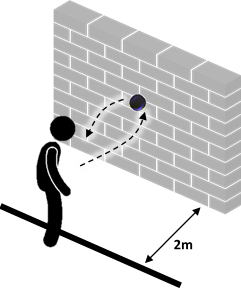This test is run by .
Note that your final mark will not be saved in the system.
Note that your final mark will not be saved in the system.
B3-B4 Fitness test methods and interpreting results for skill-related components GapFill
Target Level
Pass
Running Total
0
0%
Attempt
1 of 3
You must fill all the gaps before clicking ‘Check Answers!’

There are a number of different fitness tests to measure the skill-related components of fitness.
Reaction time:
- The test, which requires the subject to hold their hand steady level with the 0 cm line on a ruler and catch it once it is dropped by the test conductor. The measurement (in cm) where it is caught is used as a gauge of their ability at this component, with lower scores indicating a greater reaction time.
- Online reaction time tests can also be used. A common example is the test, where the subject must hit the space bar when they see the light turn green.
Coordination:
- The alternate-hand wall-throw test, which requires an individual to throw a ball against a wall away with one hand and catch it with the other. This is repeated for seconds, with the number of successful catches used as the test score.
- The stick flip coordination test, which requires the subject to place a stick horizontally across two held sticks, and then have attempts at flipping it half a turn (awarding themselves one point if they are successful). They should then repeat this, but this time flipping it a full turn (awarding themselves two points if successful). The total number of points they managed to get is used as the test score.
Agility:
- The is used to measure agility, where the performer begins by lying down in a prone position. On the command 'go', they then complete a short course around a set of cones which includes a variety of twists and turns, as quickly as possible. The greater their agility, the less time it takes them to complete the course.
- The test is another test to measure agility. It involves completing a course in the shape of the letter it is named after. The less time it takes the performer to complete the course, the greater their agility.
Balance:
- The test is used to measure balance. The participant must adopt a position with their hands on their hips and placing one foot on the inside of the standing leg. They must then raise their heel off the ground and hold the position for as long as possible. If they lose their balance, the test is stopped and the time they were able to hold the position for is recorded.
- The balance test is another test used to measure balance, this time testing balance.
Power:
- The test measures the power of the lower-body muscles. The individual starts with their side against a wall and reaches up to leave a mark with chalk or similar to indicate their standing reach height. They then complete a maximal vertical jump and mark the wall at the peak height of their jump with their outstretched arm. The distance between the two marks is used as the test score.
- The standing jump is another test to measure power. This test measures the horizontal distance the performer is able to jump from a static position.
- The test involves running up a set of nine steps, jumping three steps at a time. The distance between the 3rd and 9th step, and the time it takes to cover the distance between these steps, are used in an equation to estimate power (in watts).